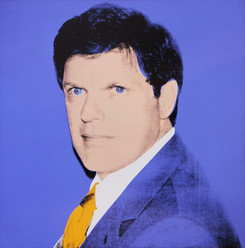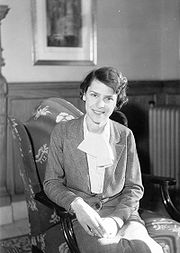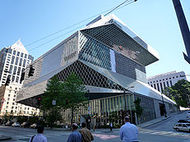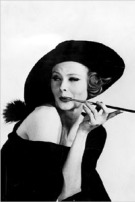Andy Warhol has been stolen again: The news broke late Friday. A very “clean” theft, police
 said, took place at the West Los Angeles home of Richard Weisman. Thieves captured a collection of works that Weisman commissioned from Warhol in the late 1970s, including 10 silk-screened portraits of athletes and one of Weisman himself (right). According to Reuters:
said, took place at the West Los Angeles home of Richard Weisman. Thieves captured a collection of works that Weisman commissioned from Warhol in the late 1970s, including 10 silk-screened portraits of athletes and one of Weisman himself (right). According to Reuters:
Among them were boxing great Muhammad Ali, tennis champion Chris Evert, Los Angeles Lakers basketball star Kareem Abdul-Jabbar, Olympic skater Dorothy Hamill and former football star turned “Trial of the Century” defendant O.J. Simpson.
An “anonymous donor” — presumably Weisman — has offered a $1 million reward for the return of the art. A housekeeper noticed that the works, which hung in Weisman’s dining room, were missing on Sept. 3, but there was no sign of forced entry.
According to the Art Loss Register, Andy Warhol is one of its top ten stolen artists. It has 212 missing Warhols in its database.
Weisman’s name should ring a bell: He comes from the famous art-collecting Weisman family: His father, Frederick R. Weisman, is responsible for the Frank Gehry-designed Frederick R. Weisman Art Museum at the University of Minnesota, an eponymous museum at Pepperdine University, and an eponymous art foundation.
Frederick Weisman once headed Hunt Foods, owned by Norton Simon (the company). He married the founder’s daughter, Marcia Simon — Norton’s sister. Norton Simon’s own collecting is of course even more legendary; here’s a link to his museum.
The Weismans built a huge collection — I heard stories of stacks of paintings (do I recall hearing that some hung on the ceilings?). Starting in the early ’50s, they bought Abstract Expressionism and Pop art before those movements earned critical acclaim, and once owned one of the most important private collections in the U.S. It was split by their divorce in 1979. Marcia gave many of her works to the Los Angeles County Museum of Art, the National Gallery of Art, and the Museum of Contemporary Art in Los Angeles. She died in 1991; he died in 1994.
Their son Richard, the victim here, published a book of his collection, Picasso to Pop: The Richard Weisman Collection, in 2003.
Here’s a link to the Reuters story and here’s a link to the LAPD’s crime alert, which has pictures of the stolen works.
Photo: Courtesy LAPD



